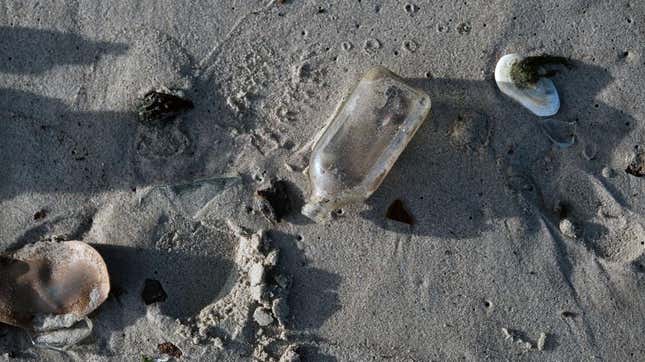
Glass can be cleaned and reused many times, but it doesn’t break down in the environment and can sit in landfills for thousands of years. A team of scientists tried to tackle this problem by developing biodegradable glass that can safely break down over a much shorter period of time.
In a study published last week in the journal Science Advances, a team at the Chinese Academy of Sciences’ Institute of Process Engineering describe how they engineered what they are calling biodegradable glass made from amino acids or peptides. The idea is that this materiel would have a smaller impact on the environment than conventional glass.
A lot of manufactured glass today is made from lime, sand, and sodium carbonate. That glass can be reused or melted down and recycled into a new item, but it’s not biodegradable. But through different tests, the researchers found that their biodegradable glass can break down in a few weeks or in several months, depending on the environment it is exposed to.

The researchers tested glass beads made from the biodegradable glass in multiple environments. They exposed glass beads to enzymes in the lab. The beads made from the amino acid-derived glass broke down in the solution after only about two days; the glass bead made out of peptides broke down in about five months.
Glass beads made out of peptides were placed also under the skin of mice, and the breakdown of the bead and the skin healing process were observed for 30 days. A diagram from the study shows how the mice’s bodies broke down the beads. In that month, the glass implant dissolved under the skin, the incision site healed, and fur grew back over where the cut was made. “Throughout the experimental period, no mice exhibited any pain-related behavior that may have been induced by the glass implantation, and none of them experienced obvious weight loss,” the researchers wrote in their paper.
They also placed their glass beads in composting soil to observe how long it would take for them to break down. The amino acid-derived bead decomposed in three weeks, while the peptide-based bead broke down after about seven and a half months, according to the study.
Though amino acids do degrade over time in the environment, this biodegradable glass isn’t as durable as conventional glass, because the peptides and amino acids can break down quickly in heat. To combat this, the researchers chemically modified the amino acids and peptides using the heating-quenching procedure used in glass manufacturing. This is when materials for the glass are heated to become soft and then rapidly cooled. It’s important to point out that this study is just one step in creating more biodegradable glass—this material isn’t ready to hit the market.
Yan Xuehai, a professor involved in the study, said in a press release that the “the biomolecular glass is currently in the laboratory stage, and far from large-scale commercialization.”
While we wait for glass that biodegrades, some groups are finding ways to repurpose glass that would otherwise sit in a landfill. In Louisiana, a group called Glass Half Full collects glass bottles and recycles them into sand that can be used to restore eroded shorelines and create sandbags for disaster preparation.